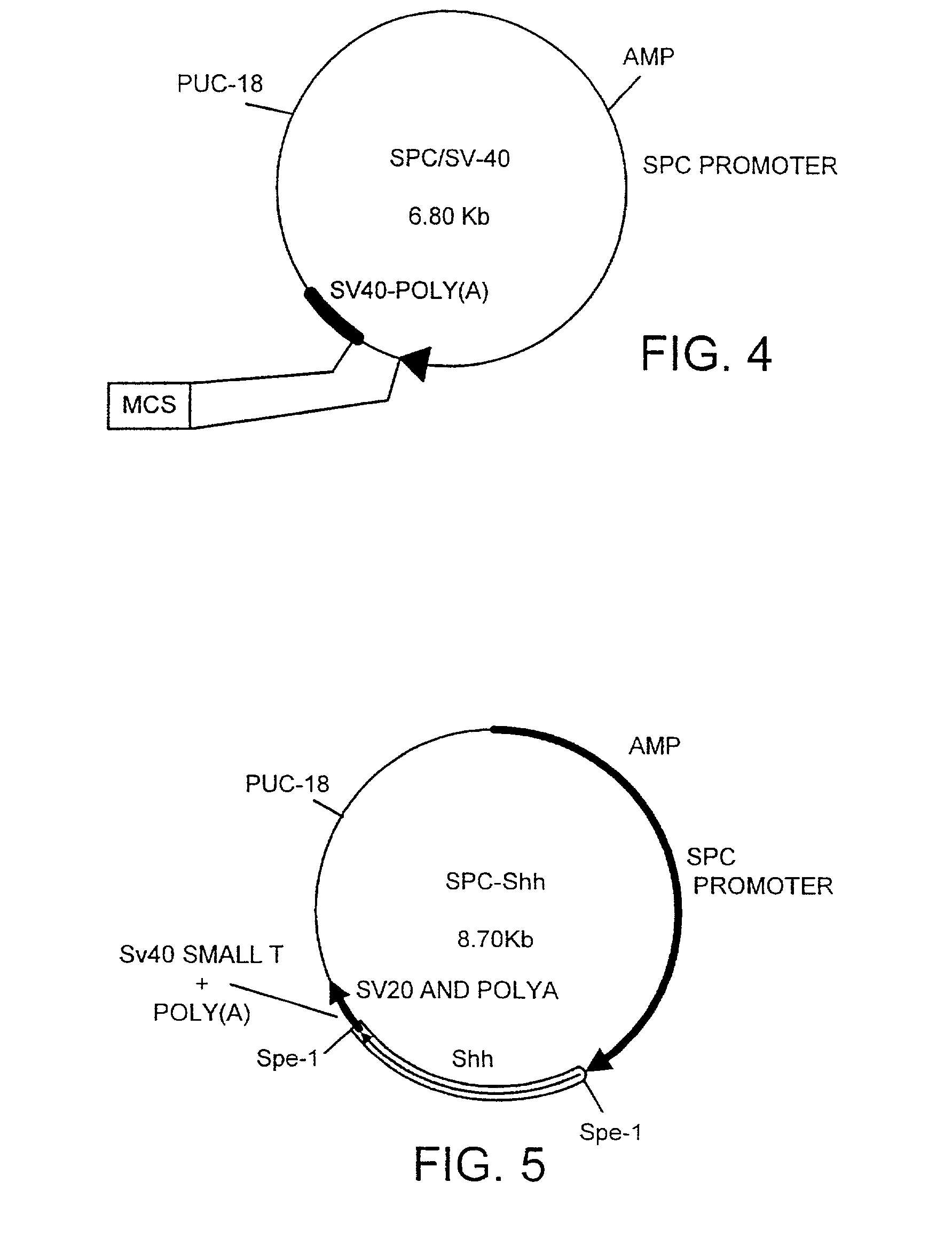Therapeutic use
a technology of epithelial cells and therapeutics, applied in the field of therapeutics, can solve problems such as difficult clinical management, and achieve the effects of reducing ptc expression, ec hyperplasia, and increasing expression of ptc-1
- Summary
- Abstract
- Description
- Claims
- Application Information
AI Technical Summary
Benefits of technology
Problems solved by technology
Method used
Image
Examples
example 2
Increased Expression of Ptc in the Lung Epithelial Cells from Human Patients with Idiopathic Fibrosing Alveolitis (IFA also known as CFA) and in a Murine Model of Interstitial Pulmonary Fibrosis (IPF).
[0217] FIG. 6C
[0218] BALB / c mice were treated intratracheally with 50 .mu.g of FITC disolved in physiological buffered saline (PBS). Three months later mice were sacrificed and lungs removed and fixed in 4% buffered formalin and embedded in paraffin. 5 .mu.m sections of lung tissue were placed onto TESPA coated slides and the expression of Ptc gene expression was examined by anti-sense RNA in situ hybridization (ISH).
[0219] Sections were hybridized with digoxigenin antisense RNA probes specific for murine Ptc1 at 65.degree. C. . The bound probe was detected by alkaline phosphatase conjugated goat anti-digoxigenin Fab and sections were developed using NBT and BCIP as the substrate. We observed increased expression of Ptc in lung epithelial cells in the murine model of IPF. Expression of...
example 3
Overexpression of Shh Leads to Epithelial Cell Hyperplasia and Lung Fibrosis.
[0222] FIGS. 7-9
[0223] BALB / c mice were injected i.t. with either (i) saline alone, (ii) 20 .mu.g of SPC plasmid dissolved in saline, or (iii) 20 .mu.g of SPC-Shh plasmid DNA dissolved in saline on day 0 and day 5. The SPC plasmid provides tissue-specific expression of a desired gene as it contains the promoter sequence from the lung epithelial cell-specific surfactant protein C (i.e. SPC). Mice were sacificed at day 12 and day 35 where upon the lungs were removed and placed into 4% buffered formalin.
[0224] 5 .mu.m sections of lung tissue (FIG. 7, 8) or trachea (FIG. 9) from each group at each of the two time points were placed onto poly-L-Lysine coated slides and stained using the haematoxylin and eosin (H & E) histochemical stain.
[0225] The groups contained:
[0226] Day 12 PBS (2 mice), SPC (2 mice) and SPC-shh (2 mice)
[0227] Day 35 PBS (3 mice) SPC (3 mice) and SPC-shh (3 mice)
[0228] Slides from the day 35...
example 4
Epithelial Cells Express High Levels of Shh Following FITC Damage
[0231] Mice were treated intratracheally with the hapten fluorescein isothiocyanate. Seven days later the lungs were removed and fixed in formalin. Sections were cut and stained for Shh by immunhistochemistry. FIGS. 10A and 10B show expression of Shh in the lung of FITC treated mice, while FIG. 10C shows the staining for Shh observed in the control lung. Shh could be detected on epithelial cells, and a higher level of Shh was detected on a basal cell population in the lung interstitium consistent in morphology with fibroblasts.
PUM
| Property | Measurement | Unit |
|---|---|---|
| Disorder | aaaaa | aaaaa |
| Hypersensitivity | aaaaa | aaaaa |
Abstract
Description
Claims
Application Information
 Login to View More
Login to View More - R&D
- Intellectual Property
- Life Sciences
- Materials
- Tech Scout
- Unparalleled Data Quality
- Higher Quality Content
- 60% Fewer Hallucinations
Browse by: Latest US Patents, China's latest patents, Technical Efficacy Thesaurus, Application Domain, Technology Topic, Popular Technical Reports.
© 2025 PatSnap. All rights reserved.Legal|Privacy policy|Modern Slavery Act Transparency Statement|Sitemap|About US| Contact US: help@patsnap.com



